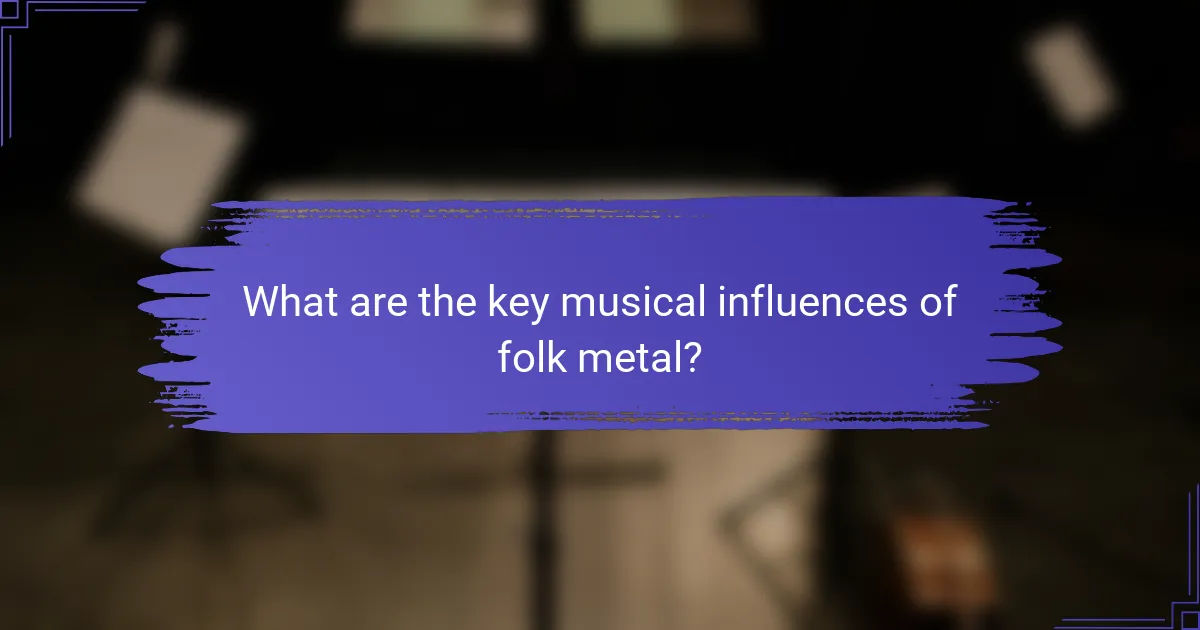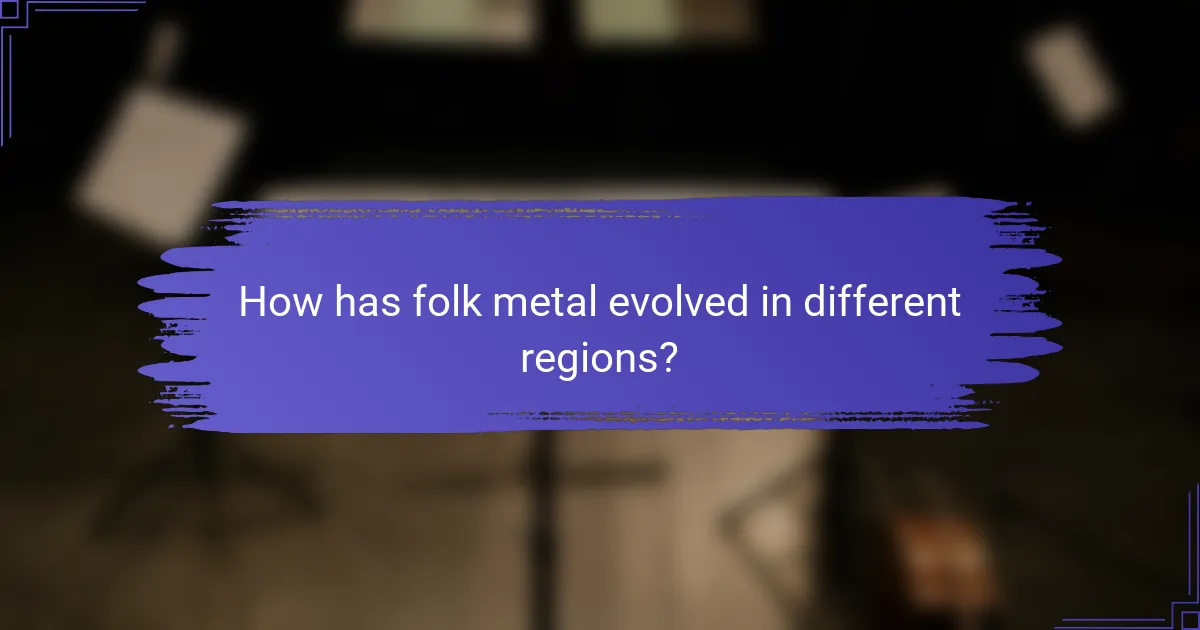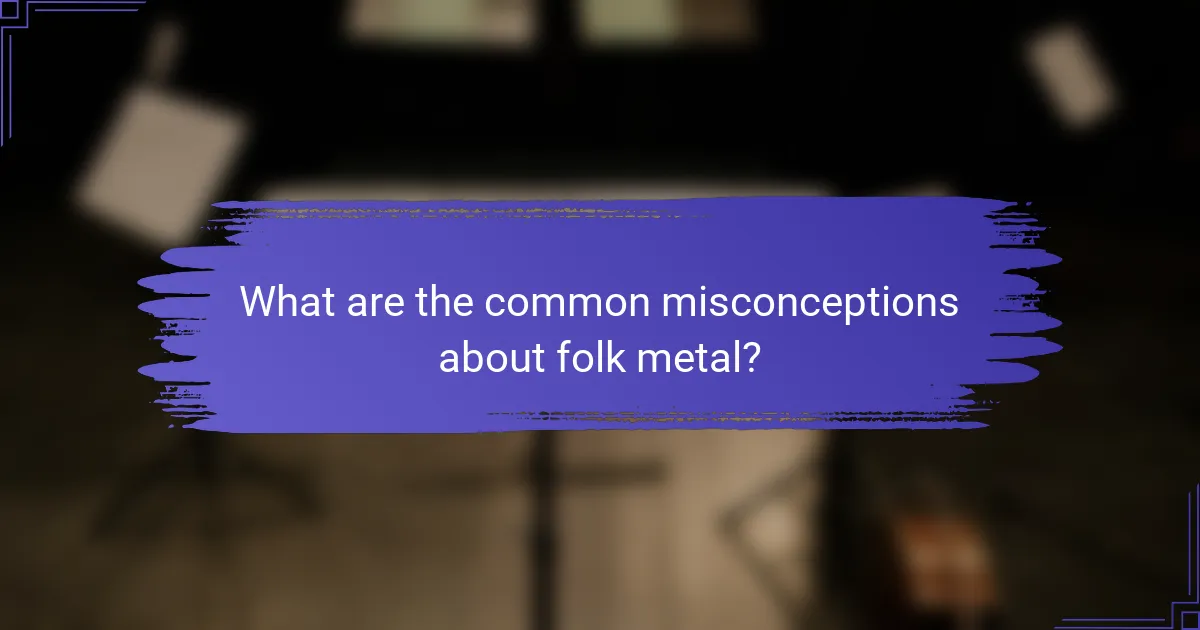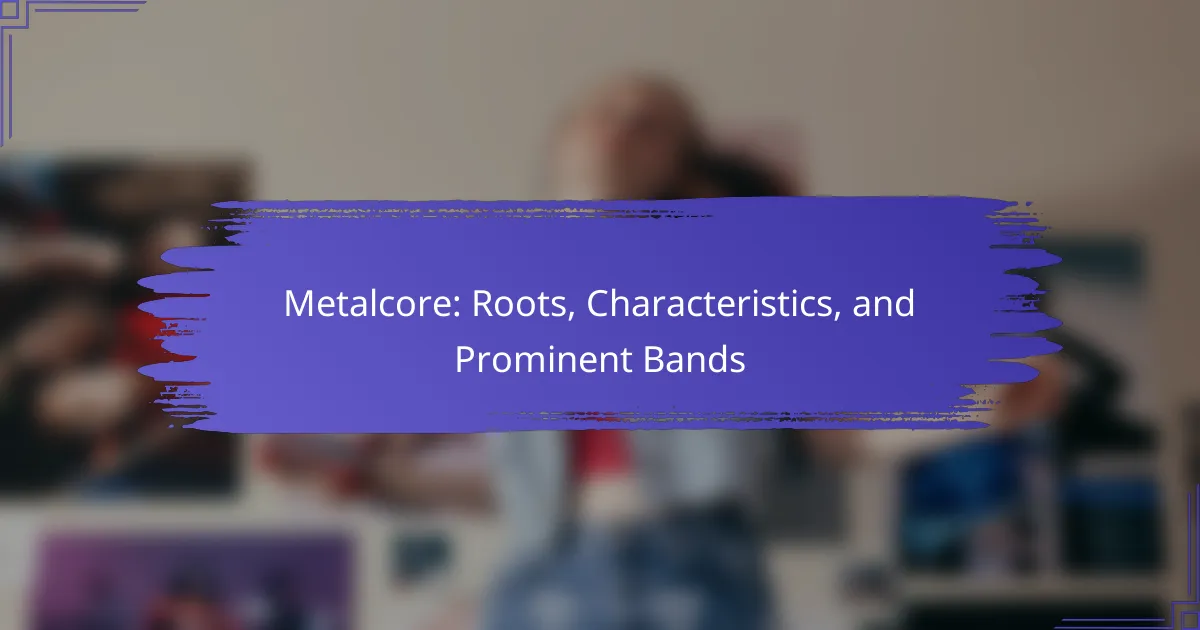Folk metal blends traditional folk music with heavy metal, creating a unique sound that resonates with cultural identity. It draws on influences from Celtic, Nordic, and Slavic traditions, while key bands like Finntroll and Eluveitie showcase this fusion. The genre explores cultural themes, historical narratives, and nature, and has evolved across different regions, reflecting local identities. Additionally, misconceptions about folk metal often overlook its rich diversity and significance within the broader metal scene.

What are the key musical influences of folk metal?
Folk metal is influenced by traditional folk music, heavy metal, and various cultural themes. Key musical influences include Celtic, Nordic, and Slavic folk traditions, which provide melodic structures and instrumentation. Additionally, elements from rock and classical music enhance the genre’s complexity. Notable bands like Finntroll and Eluveitie exemplify these influences through their fusion of folk melodies with metal aggression.
How does traditional music shape folk metal sounds?
Traditional music significantly shapes folk metal sounds by infusing cultural narratives and instruments. This genre often incorporates folk melodies, rhythms, and themes that resonate with specific regional histories. Instruments like fiddles, flutes, and bagpipes are frequently utilized, creating a distinctive blend that differentiates folk metal from other metal subgenres. Key bands, such as Finntroll and Eluveitie, exemplify how these elements merge to form a unique auditory experience that celebrates heritage while appealing to modern audiences. The integration of traditional music not only enhances the emotional depth but also fosters a sense of community among listeners.
Which instruments are commonly used in folk metal?
Folk metal commonly uses traditional instruments like the violin, flute, accordion, and bagpipes. These instruments enhance the genre’s cultural themes and folk influences. Bands often incorporate electric guitars and drums to blend folk melodies with metal elements, creating a unique sound. The combination of acoustic and electric instruments defines the folk metal style.

How do cultural themes manifest in folk metal lyrics?
Cultural themes in folk metal lyrics often reflect historical narratives, mythology, and nature. These elements create a connection to cultural identity and heritage. For instance, many bands draw inspiration from folklore, celebrating local legends and traditions. This approach allows listeners to engage with their cultural roots through music. Additionally, themes of struggle and resilience are prevalent, resonating with audiences on a personal level. Overall, folk metal serves as a vehicle for cultural expression and storytelling.
What stories and myths are frequently referenced in folk metal?
Folk metal frequently references stories and myths from various cultures, integrating themes of nature, heroism, and folklore. Common narratives include Norse mythology, Celtic legends, and Slavic tales. Bands like Finntroll and Eluveitie often draw on these rich traditions, using them to create immersive musical experiences. The blending of ancient stories with modern sounds enhances the genre’s appeal, connecting listeners to their cultural heritage.
How does folk metal reflect regional traditions and identities?
Folk metal reflects regional traditions and identities by incorporating local folklore, instruments, and themes. This genre often draws from historical narratives and cultural practices, creating a unique sound that resonates with specific communities. Bands like Finntroll and Eluveitie exemplify this connection by using traditional melodies and lyrics that celebrate their heritage. The fusion of metal with folk elements fosters a sense of belonging and pride among listeners, reinforcing cultural identities.

Which bands are considered pioneers of the folk metal genre?
The pioneers of the folk metal genre include bands such as Finntroll, Skyclad, and Korpiklaani. These bands integrated traditional folk music elements with heavy metal, creating a unique sound. Finntroll is known for its blend of Finnish folk and black metal influences, while Skyclad introduced folk instrumentation in the early 1990s. Korpiklaani emphasizes lively melodies and themes of nature and folklore. Their contributions have significantly shaped the genre’s identity and popularity.
What impact have Finntroll and Korpiklaani had on the genre?
Finntroll and Korpiklaani significantly impacted folk metal by blending traditional folk elements with metal, enhancing genre diversity. Finntroll’s incorporation of Finnish folklore and Korpiklaani’s use of folk instruments popularized cultural themes within the genre. Their energetic performances and distinct sounds have inspired numerous bands, solidifying their influence in folk metal’s evolution.
How have newer bands like Eluveitie influenced folk metal?
Newer bands like Eluveitie have significantly influenced folk metal by integrating traditional instruments and themes. Their unique blend of Celtic melodies and modern metal elements has expanded the genre’s appeal. Eluveitie’s use of storytelling in lyrics reflects cultural heritage, resonating with audiences and inspiring other bands. As a result, they have helped shape a more diverse and rich folk metal landscape.

What role does live performance play in folk metal culture?
Live performance is central to folk metal culture, fostering community and enhancing the genre’s storytelling. Concerts create immersive experiences where fans connect through shared cultural themes. Bands often incorporate traditional instruments and folklore into their performances, which deepens the audience’s appreciation. Unique attributes, such as elaborate costumes and stage setups, further enrich these live events, making them memorable. The communal atmosphere at festivals highlights the genre’s roots in folk traditions, reinforcing cultural identity.
How do folk metal festivals promote community and culture?
Folk metal festivals promote community and culture by creating spaces for shared experiences and cultural expression. These events often feature traditional music, costumes, and storytelling that reflect regional heritage. Attendees bond over a mutual appreciation for the genre, strengthening social ties. Additionally, local artisans and vendors showcase crafts, enhancing cultural visibility. Festivals foster inclusivity, inviting diverse audiences to celebrate folk traditions, thereby preserving and evolving cultural narratives.
What are the unique aspects of folk metal concerts?
Folk metal concerts are characterized by their fusion of traditional folk music elements with heavy metal. Unique aspects include the use of acoustic instruments, vibrant costumes, and audience participation. These concerts often feature themes of mythology, nature, and cultural heritage, enhancing the overall experience. Key bands like Finntroll and Eluveitie exemplify this blend, creating an immersive atmosphere that celebrates both musical complexity and cultural storytelling.

How has folk metal evolved in different regions?
Folk metal has evolved significantly across different regions, influenced by local cultures and musical traditions. In Europe, particularly in countries like Finland and Sweden, folk metal incorporates traditional folk melodies and instruments, creating a unique sound that reflects their heritage. Key bands such as Finntroll and Korpiklaani exemplify this regional style.
In contrast, the American folk metal scene often blends elements of bluegrass and country, showcasing influences from indigenous music. Bands like Agalloch and Eluveitie highlight this fusion, incorporating storytelling and themes of nature.
Eastern European folk metal, especially in countries like Hungary and Poland, emphasizes Slavic folklore, often featuring epic tales and historical themes. Bands such as Dalriada and Percival are notable for their use of traditional instruments and vocal styles.
Overall, folk metal’s regional variations demonstrate its adaptability and the way it resonates with local identities, making it a diverse and evolving genre.
What distinguishes North American folk metal from European styles?
North American folk metal distinguishes itself through its blending of local folklore and diverse musical influences. It often incorporates elements from Native American music and various immigrant traditions. In contrast, European styles typically emphasize regional folklore and mythological themes, drawing heavily from historical narratives. Key bands such as Eluveitie and Korpiklaani represent European folk metal, while North American bands like Korpiklaani and Finntroll showcase a more eclectic mix. This fusion creates a unique sound that reflects the multicultural landscape of North America.
Which rare collaborations have shaped the genre?
Rare collaborations that have shaped folk metal include projects like “Korpiklaani and Eluveitie,” which blended Finnish folk elements with Swiss Celtic influences. Another notable collaboration is “Finntroll and Ensiferum,” merging black metal and folk themes. These unique partnerships have enriched the genre’s diversity and creativity.

What are the common misconceptions about folk metal?
Folk metal often faces misconceptions that overlook its rich cultural roots and diverse influences. Many believe it exclusively features traditional instruments, while it frequently incorporates electric guitars and modern production techniques. Another common misconception is that folk metal is solely about nationalism; however, it often explores themes of mythology, nature, and personal experiences. Additionally, some assume all folk metal bands sound alike, but the genre is diverse, with distinct sounds and styles across different regions. Lastly, folk metal is sometimes dismissed as a novelty, yet it has a substantial following and contributes significantly to the broader metal scene.
Why is folk metal often misunderstood by mainstream audiences?
Folk metal is often misunderstood by mainstream audiences due to its fusion of diverse cultural themes and musical styles. Many listeners may not grasp the significance of traditional instruments and folklore narratives that define the genre. This misunderstanding arises from a lack of exposure to the cultural roots that influence folk metal, which often incorporates elements from various ethnic traditions. Additionally, the heavy metal sound may overshadow the intricate melodies and lyrical depth, leading to a perception that folk metal is merely a subgenre of metal without appreciating its rich storytelling and cultural significance.
How does the genre challenge stereotypes about metal music?
Folk metal challenges stereotypes about metal music by incorporating traditional instruments and cultural themes. This genre blends heavy metal with folk melodies, creating a unique sound that reflects diverse cultural narratives. Key bands like Finntroll and Eluveitie illustrate this fusion, showcasing regional folklore and storytelling. As a result, folk metal broadens the perception of metal, emphasizing its artistic diversity and cultural richness.
What best practices can help new listeners appreciate folk metal?
To appreciate folk metal, new listeners should explore its cultural roots, unique instrumentation, and lyrical themes. Engaging with the stories behind the music enhances understanding and enjoyment.
1. Discover the cultural influences: Folk metal often draws from traditional music and folklore. Understanding these elements can deepen appreciation.
2. Listen to key bands: Explore iconic bands like Finntroll, Korpiklaani, and Eluveitie. Their distinct sounds showcase the genre’s diversity.
3. Attend live performances: Experiencing folk metal live highlights its communal atmosphere and energetic performances, fostering a deeper connection.
4. Read lyrics: Analyzing the lyrics reveals themes of nature, mythology, and history, enriching the listening experience.
These practices can significantly enhance a new listener’s appreciation of folk metal.



